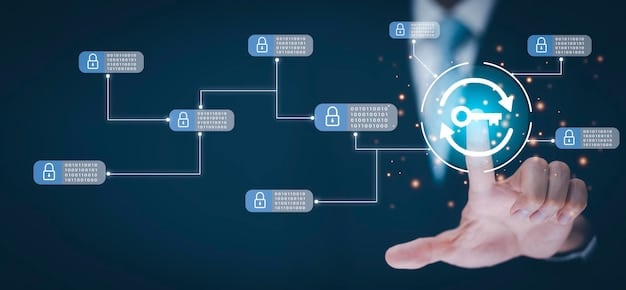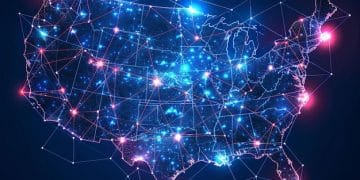US Tech: AI Ethics Guidelines 2025 Impact Explored

The updated AI ethics guidelines for 2025 will significantly influence US tech companies by mandating greater transparency, accountability, and fairness in AI development and deployment, thereby shaping innovation and market competition.
As artificial intelligence rapidly reshapes industries and daily lives, the imperative for robust ethical frameworks has never been clearer. Understanding how will the updated AI ethics guidelines impact US tech companies in 2025 is crucial for businesses aiming to remain competitive and compliant in an evolving regulatory landscape.
The Evolving Landscape of AI Regulation in the US
The United States, a global leader in technological innovation, has historically adopted a more nuanced approach to AI regulation compared to regions like the European Union. However, as AI’s pervasive influence grows, so does the recognition of its potential societal risks.
The year 2025 is poised to be a pivotal moment, with new guidelines expected to formalize principles that have, until now, largely been voluntary or fragmented across various federal agencies. This shift signals a departure from purely self-regulatory practices towards a more structured oversight.
This evolution is driven by various factors, including increasing public concern over data privacy, algorithmic bias, and autonomous decision-making. These updated guidelines aim to strike a balance: fostering innovation while safeguarding individual rights and societal well-being. Tech companies must therefore prepare to integrate these ethical considerations into every stage of their AI lifecycle, from design to deployment.
Key Drivers for Stricter AI Ethics
Several forces are converging to push for more stringent AI ethical guidelines. These include:
- Public Scrutiny: Growing awareness of AI’s potential harms, such as facial recognition inaccuracies and discriminatory lending algorithms, has fueled public demand for accountability.
- International Pressure: Global efforts, particularly from the EU, to establish comprehensive AI regulations create a ripple effect, encouraging the US to solidify its own stance to maintain international interoperability and trust.
- Technological Advancement: As AI capabilities advance rapidly, existing legal frameworks struggle to keep pace, necessitating new rules designed specifically for complex AI systems.
The federal government, through agencies like the National Institute of Standards and Technology (NIST) and the National Telecommunications and Information Administration (NTIA), has been laying the groundwork for these guidelines through frameworks, reports, and public consultations. These efforts point towards a future where AI ethics are not just a best practice, but a legal and operational mandate for US tech companies.
Accountability and Transparency: New Standards for Development
One of the most consequential impacts of updated AI ethics guidelines in 2025 will be the heightened emphasis on accountability and transparency. Historically, the internal workings of many AI systems, particularly complex deep learning models, have been described as “black boxes.” This lack of interpretability made it challenging to identify and rectify biases or understand decision-making processes.
The new guidelines are expected to push companies towards developing more interpretable and explainable AI (XAI) systems. This means not only disclosing how an AI model arrives at a particular conclusion but also being able to demonstrate that the model was developed and tested fairly, without perpetuating or amplifying existing societal biases.
For US tech companies, this translates into significant changes in their AI development pipelines. It will require robust documentation of data sources, model architectures, training methodologies, and extensive testing procedures to ensure fairness and prevent discriminatory outcomes. Furthermore, companies may need to hire or train specialized personnel capable of conducting ethical AI audits and communicating complex AI concepts to non-technical stakeholders.
Operationalizing Transparency and Explainability
Achieving greater transparency and explainability will involve a multi-pronged approach:
- Detailed Documentation: Maintaining comprehensive records of data sets, model parameters, and algorithmic choices throughout the development lifecycle.
- Interpretability Tools: Employing techniques and software that allow for the inspection and understanding of an AI model’s internal workings and predictions.
- Impact Assessments: Conducting regular AI ethical impact assessments (AIEIA) to identify potential risks and unintended consequences before deployment.
The shift towards greater transparency is not merely a compliance burden; it presents an opportunity for tech companies to build greater trust with their users and the public. By offering clearer insights into how their AI systems operate, companies can differentiate themselves in a crowded market and demonstrate a commitment to responsible innovation.
Addressing Algorithmic Bias and Fairness
Algorithmic bias is a critical concern that updated AI ethics guidelines in 2025 will directly address. Bias can creep into AI systems through unrepresentative training data, flawed assumptions by developers, or the way models are designed to optimize for certain outcomes. The consequences can be significant, leading to discriminatory practices in areas such as hiring, lending, criminal justice, and healthcare.
The new guidelines are anticipated to mandate proactive measures for identifying, mitigating, and documenting algorithmic bias. This means US tech companies will need to invest heavily in data governance, diverse data collection practices, and advanced bias detection tools. Furthermore, simply identifying bias may not be enough; companies will likely be required to demonstrate tangible efforts to redress identified biases and ensure equitable outcomes for all users.
This focus on fairness will likely push companies to reconsider their entire approach to AI development. It moves beyond technical efficiency to encompass a broader understanding of social justice and equity. Ignoring these directives could lead to significant legal penalties, reputational damage, and loss of consumer trust for non-compliant tech firms.
Mitigating Bias in Practice
Effective bias mitigation strategies will be essential:
- Diverse Data Sets: Actively sourcing and curating training data that accurately reflects the diversity of the population the AI system will serve.
- Fairness Metrics: Implementing and monitoring quantitative metrics to assess fairness across different demographic groups.
- Human Oversight: Incorporating human review and intervention at various stages of the AI lifecycle to catch and correct biased outcomes that automated systems might miss.
The challenge for tech companies will be to integrate these principles not as afterthoughts, but as fundamental components of their AI development ethos. Success in this area will not only ensure compliance but also lead to more robust, trustworthy, and socially beneficial AI solutions.

Data Governance and Privacy Protection in the AI Era
The interplay between AI and data privacy is complex and critical. Updated AI ethics guidelines in 2025 are expected to reinforce and potentially expand existing data protection principles, such as those found in frameworks like the California Consumer Privacy Act (CCPA) and forthcoming federal privacy legislation. For US tech companies, this means a renewed focus on informed consent, data minimization, and secure data handling practices specifically tailored for AI applications.
When AI systems process vast amounts of personal information, the potential for misuse or privacy breaches intensifies. The guidelines will likely demand clearer communication with users about how their data is used to train and operate AI, providing greater control over their personal information. This could include requirements for opt-in consent for certain data uses, easy access to data deletion requests, and mechanisms for correcting inaccuracies in data processed by AI.
Companies dealing with sensitive personal data – such as health, financial, or biometric information – will face even stricter regulations. The ethical imperative to protect privacy will converge with legal requirements, making robust data governance frameworks an absolute necessity. Non-compliance could result in substantial fines and a severe blow to public perception.
Strengthening Privacy Practices for AI
Key areas for bolstering data governance and privacy will include:
- Privacy-Enhancing Technologies (PETs): Adopting techniques like differential privacy and federated learning to minimize the exposure of raw personal data.
- Auditable Data Trails: Establishing clear and auditable records of how data is collected, stored, processed, and used within AI systems.
- User Control Interfaces: Developing user-friendly dashboards and settings that allow individuals to manage their data and privacy preferences related to AI services.
Navigating the data privacy landscape in 2025 will require sustained investment in legal expertise, cybersecurity measures, and transparent communication. Companies that embed privacy-by-design principles into their AI systems from the outset will be better positioned to meet these evolving challenges.
Impact on Innovation and Market Competition
The prospect of increased regulation often raises concerns about stifling innovation. However, the updated AI ethics guidelines in 2025, if thoughtfully implemented, could actually foster a healthier and more sustainable innovation ecosystem for US tech companies. By establishing clear guardrails, these guidelines can reduce regulatory uncertainty and create a level playing field, encouraging responsible rather than reckless innovation.
Companies that proactively embed ethical principles into their AI development processes may gain a significant competitive advantage. Consumers and businesses are increasingly prioritizing trust and ethical conduct when choosing technology providers. Firms with demonstrable commitments to fair, transparent, and privacy-preserving AI can differentiate themselves, attracting talent, customers, and investors.
Conversely, companies that fail to adapt could face significant setbacks. Non-compliance might lead to costly lawsuits, regulatory investigations, and a decline in market share. Smaller startups might find navigating complex ethical guidelines challenging, potentially leading to market consolidation as larger, resource-rich companies more easily absorb compliance costs.
Fostering Responsible Innovation
The impact on innovation will be multi-faceted:
- New Market Opportunities: The demand for ethical AI solutions, tools, and auditing services will create new sectors and business models.
- Enhanced Customer Trust: Ethically designed AI products can build deeper customer loyalty and trust, serving as a competitive differentiator.
- Streamlined Development: Clear guidelines, once understood, can help avoid costly reworks and reputational damage associated with ethical missteps.
Ultimately, the guidelines will push US tech companies to think beyond short-term gains and prioritize long-term societal value. This shift is not merely about compliance; it’s about shaping the future of AI in a way that respects human values and promotes inclusive growth.

Preparing for Compliance: Best Practices for US Tech Companies
For US tech companies, 2025 is not far off, and preparation for the updated AI ethics guidelines should be underway. Proactive engagement with these emerging standards will be key to minimizing disruption and maximizing the benefits of responsible AI development. The first step involves understanding the specific details of the guidelines as they are finalized, which will require continuous monitoring of legislative and regulatory developments at both federal and state levels. Companies should not wait for the final rule; instead, they should begin integrating anticipated requirements into their current practices.
Establishing an internal AI ethics committee or assigning a dedicated ethics officer can streamline the interpretation and implementation of these guidelines. This team would be responsible for developing internal policies, conducting ethical reviews of AI projects, and ensuring that all employees involved in AI development, deployment, or sales are adequately trained on the new standards. Furthermore, engaging with AI ethics experts and third-party auditors can provide invaluable insights and an objective assessment of a company’s readiness.
Key Compliance Strategies
Effective preparation will involve several strategic actions:
- Internal Audits: Regularly auditing existing AI systems for compliance with anticipated ethical principles, including bias detection and transparency.
- Employee Training: Providing comprehensive training programs for all staff on AI ethics, responsible data handling, and new regulatory requirements.
- Stakeholder Engagement: Actively soliciting feedback from diverse stakeholders, including user groups and advocacy organizations, to better understand ethical concerns and incorporate them into AI design.
The journey towards ethical AI is continuous, requiring ongoing adaptation and commitment. By adopting these best practices, US tech companies can transform compliance challenges into opportunities for leadership and innovation in the AI era.
The Future Landscape: Beyond 2025 and Global Harmonization
While 2025 represents a significant milestone for AI ethics guidelines in the US, the journey towards fully mature and integrated ethical AI is ongoing. The updated guidelines will likely serve as a foundational layer, with subsequent iterations and refinements expected as AI technology continues to evolve and societal impacts become clearer. US tech companies should view these 2025 guidelines not as a final destination, but as a crucial step in an evolving regulatory environment.
Looking beyond the immediate future, there will be increasing pressure for global harmonization of AI ethics and regulations. As AI systems are often developed in one country and deployed worldwide, discrepancies in ethical standards can create significant friction and compliance headaches. US tech companies operating internationally will need to navigate a patchwork of regulations, making a strong internal ethical framework even more vital.
Collaboration between governments, industry, academia, and civil society will be essential to shape a future where AI benefits all without compromising fundamental human rights or perpetuating societal harms. The US, with its strong tech sector, has a unique opportunity to lead in this global conversation, influencing the development of universally accepted ethical AI principles.
Anticipating Future Trends
Key considerations for the long-term include:
- Dynamic Adaptation: Designing internal processes that can flexibly adapt to future regulatory changes and emerging ethical challenges.
- International Standards: Participating in and contributing to the development of international AI ethics standards and best practices.
- Values-Based AI: Cultivating a corporate culture that prioritizes ethical considerations as an intrinsic part of AI innovation, not merely a compliance burden.
The ethical development and deployment of AI will remain a paramount challenge and opportunity for US tech companies. Those that embrace a forward-looking, values-driven approach will be the ones that thrive and meaningfully contribute to a responsible AI future.
| Key Area | Core Impact in 2025 |
|---|---|
| 📊 Transparency & Accountability | Mandates clearer explanations of AI decisions and processes. |
| ⚖️ Algorithmic Fairness | Requires proactive mitigation of biases in AI systems and data. |
| 🔒 Data Privacy Protection | Strengthens user control and secure handling of data by AI. |
| 💡 Innovation & Competition | Fosters responsible innovation and creates a level playing field. |
Frequently Asked Questions About AI Ethics Guidelines
The main goals are to ensure AI systems are developed and used responsibly, promoting fairness, transparency, and accountability. They aim to protect individual rights, mitigate societal risks like bias, and foster public trust in AI while still encouraging technological innovation within the US tech sector.
While some aspects might begin as voluntary frameworks, key provisions are expected to evolve into mandatory compliance requirements, especially for AI applications touching upon critical sectors like finance, healthcare, and employment. Companies should prepare for a significant shift from self-regulation to enforced standards.
Smaller startups might face challenges in resource allocation for compliance, potentially increasing operational costs. However, these guidelines also level the playing field by setting universal standards, which can drive innovation in ethical AI solutions that both large and small companies will need to adopt. It creates new opportunities for ethical AI tools.
Transparency and explainability are central, requiring companies to better articulate how their AI systems make decisions. This includes documenting data sources, model methodologies, and prediction logic. The goal is to move away from ‘black box’ AI, allowing for better identification and rectification of errors or biases by users and regulators.
Companies should proactively establish internal AI ethics committees, invest in employee training on ethical AI principles, conduct regular ethical audits of their AI systems, and integrate privacy-by-design methodologies. Engaging with legal experts and monitoring regulatory developments are also crucial steps for smooth adaptation.
Conclusion
The updated AI ethics guidelines for 2025 represent a significant inflection point for US tech companies, transitioning the industry towards a more structured and responsible approach to AI development and deployment. These changes, while demanding substantial investment in compliance and revised operational practices, carry the promise of building greater public trust and fostering an environment of sustainable innovation. Companies that proactively embrace these ethical imperatives will not only meet regulatory requirements but also position themselves as leaders in a future where AI’s power is harnessed for collective good, ensuring that technological progress aligns with societal values.





